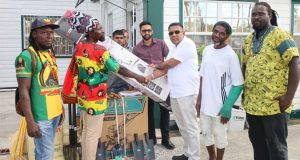By Nicole Best
Caribbean Correspondent
PORT OF SPAIN, Trinidad CMC – Reluctance to fully implement the health and family life education (HFLE) programs in Caribbean schools have been identified as major factors contributing to the high prevalence of adolescent pregnancy in the Caribbean, according to a United Nations Population Fund (UNFPA) report.
The 2013 UNFPA’s State of the World Report also indicates that continuous bombardment in the media of programs and advertisements with sexual overtones have also contributed to the situation.
According to the UNFPA State of World Population report 2013, entitled Motherhood in Childhood in the Caribbean, despite the fall in total fertility rate, adolescent birth rates remain relatively high.
It said that among girls aged 15 – 19 years old, the birth rate ranges from 26 to 97 per 1,000 adolescent girls.
Guyana, Belize, Jamaica, Antigua and Barbuda and Suriname have the highest teen pregnancy rates in the Caribbean.
UNFPA’s sub-regional office Assistant Representative, Aurora Noguera Ramkissoon, said the reluctance to teach HFLE in schools stems from fear that faith-based organizations may brand the education system as promoting sex instead of empowering young people to abstain.
“There is a kind of dichotomy in the region where we’re very much influenced by our colonial past, our religious past, so there is some reluctance to fully implement the Health and Family Life Education,” Ramkissoon told regional media, at a briefing held on Friday.
The briefing comes ahead of a high level meeting on Monday where the findings of the report will be discussed.
“So on the one hand we have that reluctance but on the other hand, we’re getting constant messages about sex, and drinking alcohol, particularly in both our local music and music that is coming from North America that is pushing sexual activity,” she told reporters.
The Caribbean Community (CARICOM) has mandated that HFLE be taught at all schools in the region, but Ramkissoon said more often than not, an abridged version was what was being taught at schools.
“Sometimes they teach the hygiene portion or the values portion but are reluctant to touch on the sexuality,” Ramkissoon said.
But UNFPA’s Regional Communications Advisor to Latin America and the Caribbean, Alvaro Serrano, told reporters that a number of young girls in Latin America got pregnant early as a sign of status, within gangs.
“In Latin and Central America, adolescent pregnancy has been identified as an action of status…so girls get married very young because that is a status that they acquire as part of the young groups.”
Other major contributing factors are said to be sexual abuse of young girls and poverty.
President of the United Nations General Assembly, Ambassador John W. Ashe, along with the UNFPA Executive Director, Dr. Babatunde Osotimehin, will on Monday chair a meeting of CARICOM ministers, aimed at developing a strategic approach to tackling adolescent pregnancy in the Caribbean.
“The purpose is to meet for one day to discuss the situation analysis of adolescent pregnancy in the Caribbean and based on that, establish a plan of action; a work plan that would be implemented with the support of all the governments in order to change this reality,” said Serrano.
“There is in the report, a lot of evidence that the more time a girl stays in school, the better for the families, the better for the countries, the better for society,” Alvaro Serrano said.
 Pride News Canada's Leader In African Canadian & Caribbean News, Views & Lifestyle
Pride News Canada's Leader In African Canadian & Caribbean News, Views & Lifestyle




